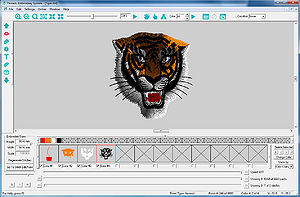Difference between revisions of ".dst"
Jump to navigation
Jump to search
(add pic) |
(update) |
||
| Line 6: | Line 6: | ||
The Tajima .dst format is a dependable commercial format that has been around since before the era of modern computers. For that reason, the Tajima .dst file can not store the color palette. It does not have the ability to save RGB (red, green, blue) color values at the color changes. | The Tajima .dst format is a dependable commercial format that has been around since before the era of modern computers. For that reason, the Tajima .dst file can not store the color palette. It does not have the ability to save RGB (red, green, blue) color values at the color changes. | ||
Even | Even though the (.dst) data does not contain specific thread color information, the Tajima file type remains the most common format found in the embroidery industry. | ||
Revision as of 18:01, 10 October 2013
A file with a .dst file extension is a design file intended for embroidery machines. The common .dst extension is a stitch-based file format popularized by Tajima commercial embroidery sewing machines. To open a .dst file typically requires some type of embroidery digitizing software.
The Tajima .dst format is a dependable commercial format that has been around since before the era of modern computers. For that reason, the Tajima .dst file can not store the color palette. It does not have the ability to save RGB (red, green, blue) color values at the color changes.
Even though the (.dst) data does not contain specific thread color information, the Tajima file type remains the most common format found in the embroidery industry.
